Unpacking and publishing the Phaistos Disk since 1993
HOME | PREVIOUS | NEXT | SITEMAP
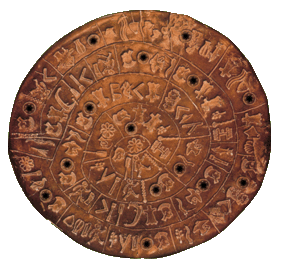
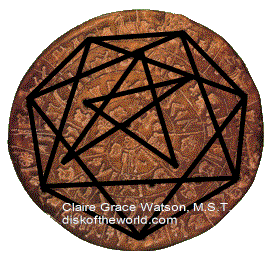
In this respect, the Phaistos Disk represents the night sky and the pictographs might be abbreviations for constellations. The spirals on the two sides of the disk would represent the revolution of the circling constellations in the Northern and Southern hemispheres, and the line segments would represent the division and measurement of the year.
Maybe the star on the disk, a pentagram inside a heptagram, is the star Sirius inside the seven known planets, or perhaps it is the path of Venus. In ancient civililzations, when the people had a mythical view of the world, it was the similarities of things and ideas that fascinated their minds. The star on the disk probably represented many similar things: constellations, Sirius, path of Venus and even more.
In history, there is a so much information about Sirius, about its place of importance in the lives and concepts of Egyptians and apparently Minoans. Their Sothic Calendar was based upon its movement.
In the mysticism of the ancient Isis-Osiris religion, the pentagram inside the heptagram is supposed to represent Sirius surrounded by the seven known planets. The members of that ancient religion are generally believed to have been conducting their mysterious rituals inside the Great Pyramid, perhaps in the subterranean chamber and perhaps using that design as a religious symbol or magical talisman. Was the artist(s) who did this was one of them or could their group have done it?
Another wagon wheel illusion and perhaps another pictograph-in-motion. The heptagram appears to be spinning counterclockwise, perhaps indicating the Milky Way. It might represent the circumnavigation of the stars or perhaps it conjectures about stars as being the composition of spiral galaxies.
I think the Phaistos Disk (above, blue) was created by an ancient Minoan astronomer-priest and inventor, Daedalus, which could also have been the name of a group of Minoan and Egyptian visionaries, inventors and artists.
 Jonas: Connected pictograms of shields form a star inside. Is that an indication to relation of Phaistos disk to Cosmos? What kind of star it could be?
Jonas: Connected pictograms of shields form a star inside. Is that an indication to relation of Phaistos disk to Cosmos? What kind of star it could be? Claire: It is widely believed we get our 48 major constellations and names from Crete. Connecting all the shields on Side 1 of the disk produces the star just as connecting stars produces constellations. I think this hidden star is related to the Minoans' great accomplishment in astronomy - the identification and naming of the constellations.
Claire: It is widely believed we get our 48 major constellations and names from Crete. Connecting all the shields on Side 1 of the disk produces the star just as connecting stars produces constellations. I think this hidden star is related to the Minoans' great accomplishment in astronomy - the identification and naming of the constellations.















15 Side A
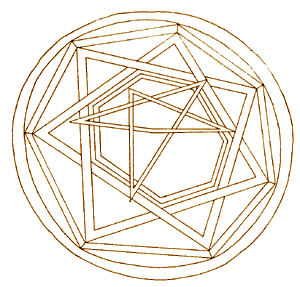


 Excavate the stars by connecting the 15 Shield pictographs with the heptagon in the center (left). a pictographic instruction to "connect the dots," to reveal this pentagram/heptagram combination, two geometrical forms part of containment of geometrical arrangements. This might represent the known universe, the seven planets known at that time including the sun and the moon and excluding Earth; they are Saturn, Jupiter, Mars, Mercury and Venus. Or it could be star Sirius or stars connected by lines to reveal constellations. The stars are chaos also, but by connecting them with lines images appear that were there the whole time, just hidden like on the Phaistos Disk. It's a though the Minoans had the idea that the secret of the universe, held in place by the stars, can be revealed by use of geometry, and that the secret revealed is geometry itself. From this comes the ancient idea of "sacred geometry." (In our modern world, we try to reveal the "secret" of the universe by atom smashing, a violent, destructive approach to gaining knowledge.)
Excavate the stars by connecting the 15 Shield pictographs with the heptagon in the center (left). a pictographic instruction to "connect the dots," to reveal this pentagram/heptagram combination, two geometrical forms part of containment of geometrical arrangements. This might represent the known universe, the seven planets known at that time including the sun and the moon and excluding Earth; they are Saturn, Jupiter, Mars, Mercury and Venus. Or it could be star Sirius or stars connected by lines to reveal constellations. The stars are chaos also, but by connecting them with lines images appear that were there the whole time, just hidden like on the Phaistos Disk. It's a though the Minoans had the idea that the secret of the universe, held in place by the stars, can be revealed by use of geometry, and that the secret revealed is geometry itself. From this comes the ancient idea of "sacred geometry." (In our modern world, we try to reveal the "secret" of the universe by atom smashing, a violent, destructive approach to gaining knowledge.)
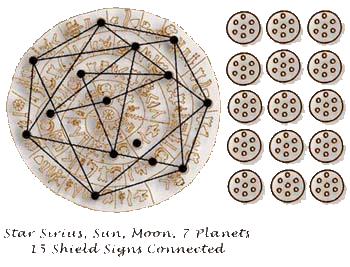

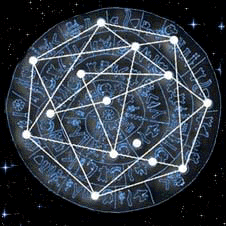

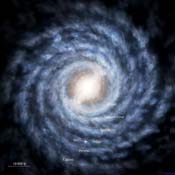
![]()
![]()
![]()
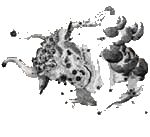 If the 48 unique pictographs on the disk represent our 48 constellations, they would need to be "abbreviated" to fit the disk. That would make them difficult to identify.
For example, the entire constellation Taurus might be represented by the bull's foot on the disk (left) or all of
Capricorn could be represented by the horn (left) or Aries represented by the Ram pictograph (above).
If the 48 unique pictographs on the disk represent our 48 constellations, they would need to be "abbreviated" to fit the disk. That would make them difficult to identify.
For example, the entire constellation Taurus might be represented by the bull's foot on the disk (left) or all of
Capricorn could be represented by the horn (left) or Aries represented by the Ram pictograph (above).
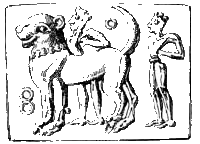 The Minoans may have included the symbols for the constellations in much of their art and not just on the Phaistos Disk. Is this just an impossibly huge dog on a bead-seal or could it represent the "Great Dog constellation," Canis Major and the "dog star" Sirius? The circle above the great dog could read "star" and the figure 8 symbol to the left, two stars combined, could read "star group" or constellation, in this case Greater Dog, Canis Major, with the largest star in the sky, Sirius. The figure 8 might therefore be a pictograph for constellation and it is also a clue to the solution of the Phaistos Disk maze puzzle. If it is a sign for constellation, this would make the puzzle solution even more a-mazing!
The Minoans may have included the symbols for the constellations in much of their art and not just on the Phaistos Disk. Is this just an impossibly huge dog on a bead-seal or could it represent the "Great Dog constellation," Canis Major and the "dog star" Sirius? The circle above the great dog could read "star" and the figure 8 symbol to the left, two stars combined, could read "star group" or constellation, in this case Greater Dog, Canis Major, with the largest star in the sky, Sirius. The figure 8 might therefore be a pictograph for constellation and it is also a clue to the solution of the Phaistos Disk maze puzzle. If it is a sign for constellation, this would make the puzzle solution even more a-mazing!
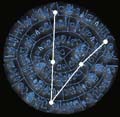
 A pictograph used as a constellation abbreviation that made perfect sense to the Minoans and
was immediately recognizable by them might make no sense to us at all. For example, why would the ancient Egyptians use a cow to symbolize the sky?? And while the number of constellations, 48, remains the same, the Minoans
may have drawn the constellations differently or the constellations may have evolved into something quite different over time.
(Perfect Canis Major showing the location of the major stars and Sirius, right, revealed when the five
A pictograph used as a constellation abbreviation that made perfect sense to the Minoans and
was immediately recognizable by them might make no sense to us at all. For example, why would the ancient Egyptians use a cow to symbolize the sky?? And while the number of constellations, 48, remains the same, the Minoans
may have drawn the constellations differently or the constellations may have evolved into something quite different over time.
(Perfect Canis Major showing the location of the major stars and Sirius, right, revealed when the five ![]() identical Boat signs on side 2 are connected with lines.)
identical Boat signs on side 2 are connected with lines.)
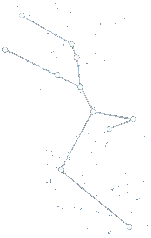

Constellation Taurus on the Phaistos Disk?
(left)
The constellation as it is drawn today (right).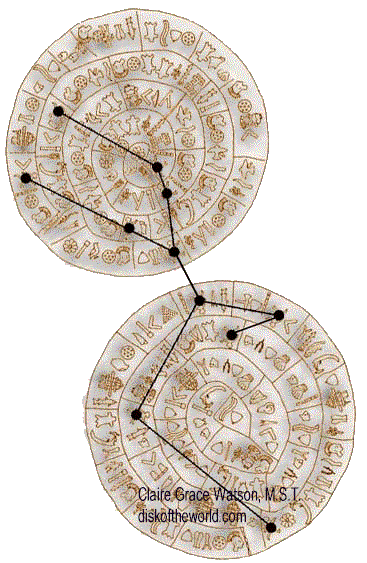
Constellation Taurus?















Then I read the unique interpretation that the disk describes the history of [Thisea] and [Argonayton] from [Kler] [Goyatson] (Claire Grace Watson): It showed how the conjunction with lines of similar symbols on ton disk they gave the depiction of [gnostoteron] constellations. And then I remembered what connected the Disk of [Faistoy] with the [yperdoynabioys] Thraces that reported [Fokoyno]: In 2002 [bre] [thike] in Nebra of Saxon a cupreous disk of diameter 30 hundredth with golden astrological representations of age of 3.600 years. (Gia Kvashilava in Georgian,The Secret Alphabet of the Phaistos)

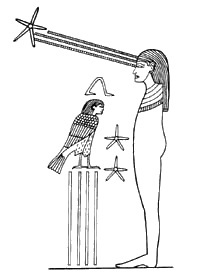
 Could the Sunflower pictograph in the center of the Phaistos Disk be the identification of the Sunflower Galaxy?
Could the Sunflower pictograph in the center of the Phaistos Disk be the identification of the Sunflower Galaxy?
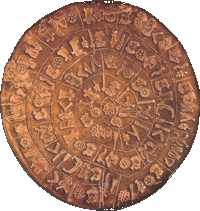

Copyright Notice - Disk of the World - Text and images copyrighted March 21, 1993-2025, Claire Grace Watson, B.A., M.S.T., U.S. Copyright and under the Digital Millennium Copyright Act of 1998, All rights reserved. No part of this web page may be reproduced or transmitted in any form or by any means without written permission from the author, except for the inclusion of brief quotations in a review.